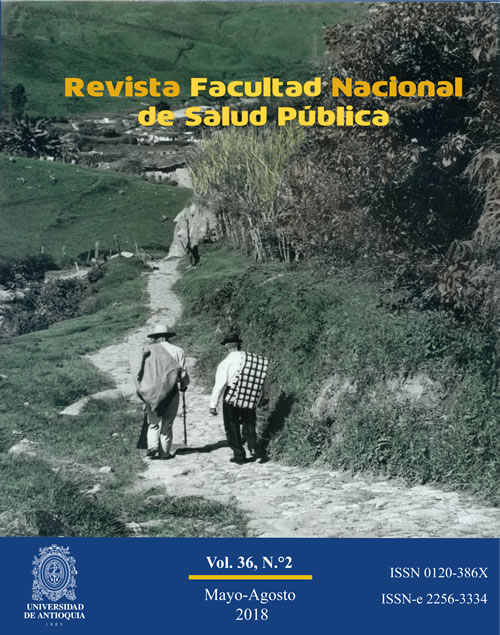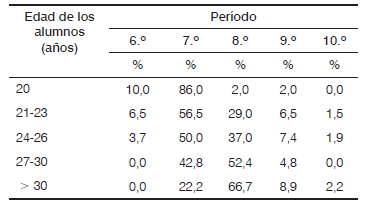Medicine Students´ Knowledge about Agrochemical Poisoning
DOI:
https://doi.org/10.17533/udea.rfnsp.v36n2a09Keywords:
agrochemicals, pesticides, poisoning, medical trainingAbstract
Introduction: human health has been severely harmed by intensive use of agrochemicals in agriculture. Identification of cases, association with the use of toxics, treatment and appropriate prevention do not seem to be happening any time soon. Objective: to verify the knowledge of medicine students at the Federal University of Paraná to identify agrochemical poisoning. Methodology: cross-sectional research with 235 students from third to fifth year, chosen by convenience, who filled out a questionnaire. The collected data were analyzed using descriptive statistics and with the variance analysis tests. Results: from all the participants 98% had already heard about poisoning caused by agrochemicals, 44% affirmed to know the symptoms, 13% said they could treat poisoned patients. After assessing their knowledge on chronic poisoning’s signs and symptoms and designated tests and treatment, it was observed that, regardless of having taken or not an elective toxicology course, 30% of students did not know the signs and symptoms, 60% did not know which were the appropriate laboratory tests to run, and 65% did not know how to treat this poisoning. Additionally, 9.36% did not know that it was necessary to notify this type of cases. Conclusions: the medicine students of the school where the study was carried out have low knowledge about agrochemical poisoning. Even if most of them can point out possible consequences of agrochemical exposure, they do not know how to diagnose or treat agrochemical poisoning, and their level of knowledge does not improve with the progression of the course.
Downloads
References
Brasil. Lei 7.802, Cap I. Art 1o IV de 11 de julho de 1989. Dispõe sobre a pesquisa, a experimentação, a produção, a embalagem e rotulagem, o transporte, o armazenamento, a comercialização, a propaganda comercial, a utilização, a importação, a exportação, o destino final dos resíduos e embalagens, o registro, a classificação, o controle, a inspeção e a fiscalização de agrotóxicos, seus componentes e afins, e dá outras providências. Diário Oficial da República Federativa do Brasil, Brasília, 1989.
Minasi LB, Costa EO, Silva DM, Melo CO, Almeida JG de, Vieira TC et al. Cytogenetic damage in the buccal epithelium of Brazilian aviators occupationally exposed to agrochemical. Genet Mol Res. 2011;10(4):3924-9.
Souza AC, Deitos A, Souza A et al. Avaliação do impacto de exposição a agrotóxicos sobre a saúde de população rural: Vale do Taquari (RS, Brasil). Ciênc. Saúde Coletiva (Rio de Janeiro). 2011;16(8): 3519-28.
Pasiani JO, Torres P, Silva JR et al. Knowledge, attitudes, practices and biomonitoring of farmers and residents exposed to pesticides in Brazil. Int J Environ Res Public Health [Internet]. 2012 [citado 2017 feb. 14]; 9(9):3051-68. Disponible en: http://repositorio.unb.br/bitstream/10482/13074/1/ARTIGO_KnowledgeAttitudesPractices.pdf
Rigotto RM. Os conflitos entre o agronegócio e os direitos das populações: o papel do campo científico. Agroecologia. 2013;7:133-42.
Zortéa T, Baretta D, Maccari AP et al. Influence of cypermethrin on avoidance behavior, survival and reproduction of Folsomia candida in soil. Chemosphere. 2015;122:94-98.
Ferreira MJM, Viana Junior MM. A expansão do agronegócio no semiárido cearense e suas implicações para a saúde, o trabalho e o ambiente. Interface Comum Saúde Educ (Botucatu). 2016;20(58):649-60.
Carneiro FF, organizador. Dossiê ABRASCO: um alerta sobre os impactos dos agrotóxicos na saúde. Rio de Janeiro: Escola Politécnica de Saúde Joaquim Venâncio/Fiocruz. São Paulo: Editora Expressão Popular; 2015.
Agência Nacional de Vigilância Sanitária. Programa de Análise de Resíduos de Agrotóxicos em Alimentos (PARA). Relatório das análises das amostras monitoradas no período de 2013 a 2015. Brasília, DF. [Internet]. 2016 [citado 2017 feb. 14]. Disponible en: http://portal.anvisa.gov.br/documents/111215/0/Relat%C3%B3rio+PARA+2013-2015_VERS%C3%83O-FINAL.pdf/494cd7c5-5408-4e6a-b0e5-5098cbf759f8
Secretaria de Estado da Saúde do Paraná, Superintendência de Vigilância em Saúde, Centro Estadual de Saúde do Trabalhador. Protocolo de avaliação das intoxicações crônicas por agrotóxicos. Curitiba, Paraná. [Internet] 2013. [citado 2017 mar. 28]. Disponible en: http://www.saude.pr.gov.br/arquivos/File/CEST/Protocolo_AvaliacaoIntoxicacaoAgrotoxicos.pdf
Duarte N. Sociedade do conhecimento ou sociedade das ilusões?: quatro ensaios crítico-dialéticos em filosofia da educação. Campinas, SP: Autores Associados; 2008.
Martins LM. Ensino-pesquisa-extensão como fundamento metodológico da construção do conhecimento na universidade. In: Oficina de Estudos Pedagógicos, São Paulo: UNESP [Internet]; 2007 [citado 2018 ene. 20]. Disponible en: https://www.academia.edu/31377941/ENSINO_PESQUISA-EXTENS%C3 %83O_COMO_FUNDAMENTO_METODOL%C3 %93GICO_DA_CONSTRU%C3 %87 %C3 %83O_DO_CONHECIMENTO_NA_UNIVERSIDADE
Albuquerque GSC, Rodrigues BS, Rocha EG, Carvalho ILF, Marques ICS, Lima RL, et al. Integração ensino/serviço/comunidade: a extensão como constituinte orgânica da formação universitária. Relato de experiência. Revista Ciência em Extensão [Internet]; 2015 [citado 2018 ene. 5]; 11(2):151-160. Disponible en: http://ojs.unesp.br/index.php/revista_proex/article/view/1144/1110
Beitz J, Castro AB de. Integrating environmental health into nurse practitioner training childhood pesticide exposure risk assessment, prevention, and management. AAOHN J. 2010;58(8):349-55.
Arias S. Inequidad y cáncer: una revisión conceptual. Rev. Fac. Nac. Salud Pública. 2009;27(3):341-8.
Schier JG, Rubin C, Schwartz MD et al. Public Health Partnerships in Medical Toxicology Education and Practice. AJPM. 2010;38(6):667-74.
Halm BM, Lee MT, Franke AA. Improving toxicology knowledge in preclinical medical students using high-fidelity patient simulators. Hawaii Med J. 2011;70(6):12-15.
Thomas MC, Macias-Moriaty LC. Student knowledge and confidence in an elective clinical toxicology course using active-learning techniques. Am J Pharm Educ. 2014;78(5):95.
Wong A, Vohra R, Ruha AM, Graeme K, Dargan PI, Wood DM, Greene SL. The Global Educational Toxicology Uniting Project (GETUP): An analysis of the first year of a novel toxicology education project. J Med Toxicol. [Internet]; 2015 [citado 2018 ago. 13]; 11(3):295-300. Disponible en: https://www.ncbi.nlm.nih.gov/pubmed/25952764
Rivkin A, Gim S. Student preferences regarding teaching methods in a drug-induced diseases and clinical toxicology course. Am J Pharm Educ. 2013;77(6):1-7.
Wallace H, Roberts R, Corsini E, Bonefeld-Jorgensen E, Orhan H. Toxicology as an academic discipline in European Universities. Toxicology Letters. 2016;254(63).
Mandrioli D, Silbergeld EK. Evidence from toxicology: The most essential science for prevention environmental health perspectives. 2016;124(1):6-11.
Goktas S, Yildirim G, Kose S, Yildirim S, Ozhan F, Senturan L. First aid knowledge of university students in poisoning cases. Turk J Emerg Med. 2014;14(4):153-9.
Karr C, Murphy H, Glew G, Keifer MC, Fenske RA. Pacific Northwest health professionals survey on pesticides and children. J Agromedicine. 2006;11(3/4):113-20.
Thundiyil JG, Stober J, Besbelli N, Pronczuk J. Acute pesticide poisoning: A proposed classification tool. Bulletin of the World Health Organization. 2008;86(3):205-9.
Londres S. Agrotóxicos no Brasil: Um guia para ação em defesa da vida. Rio de Janeiro: AS-PTA-Assessoria e Serviços a Projetos em Agricultura Alternativa; 2011.
Germer C. O Capital de Marx como expressão de um método inovador. Revista de Economia. 2008;34(4):21-44.
Quintana AM, Rodrigues AT, Arpini DM, Bassi LA, Cecim PS, Santos MS. A angústia na formação do estudante de medicina. Rev. Bras. Educ. Med. 2008;32(1):7-14.
Published
How to Cite
Issue
Section
License
The contents of the articles are the responsibility of the authors
The editorial committee has editorial independence from the National School of Public Health "Héctor Abad Gómez" of the University of Antioquia.
The editorial committee is not responsible for aspects related to copying, plagiarism or fraud that may appear in the articles published in it.
When you are going to reproduce and disclose photographs or personal data in printed or digital format, informed consent is required. Therefore, this requirement is required of the author at the time of receipt of the manuscript.
Authors are responsible for obtaining the necessary permissions to reproduce any material protected by reproduction rights.
The authors preserve the moral rights and assign the economic rights that will correspond to the University of Antioquia, to publish it, distribute electronic copies, include them in indexing services, directories or national and international databases in Open Access, under the Creative Commons Attribution license -Not Commercial-Share Equal 4.0 International Commercial (CC BY-NC-SA) which allows others to distribute, remix, retouch, and create from the work in a non-commercial way, as long as the respective credit and license are granted. new creations under the same conditions.
The authors will sign the declaration of transfer of economic rights to the University of Antioquia, after the acceptance of the manuscript.
The editorial committee reserves the right to reject the articles whose authors do not offer satisfactory explanations about the contribution of each author, to meet the criteria of authorship in the submission letter. All authors must meet the four criteria of authorship according to ICMJE: "a) .- That there is a substantial contribution to the conception or design of the article or to the acquisition, analysis or interpretation of the data. b) That they have participated in the design of the research work or in the critical review of its intellectual content. c) .- That has been intervened in the approval of the final version that will be published.d). That they have the capacity to respond to all aspects of the article in order to ensure that issues related to the accuracy or integrity of any part of the work are adequately investigated and resolved. "















 --
--  --
--
